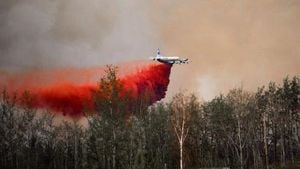Australia's beautiful yet treacherous landscapes often entice tourists and adventure-seekers, but beneath their splendor lies the lurking danger of its native wildlife. Recently, the tragic story of Dr. David Hogbin, who lost his life to crocodile attack, serves as both a heart-wrenching reminder and cautionary tale about the risks of outdoor activities near crocodile habitats.
Dr. Hogbin, 40, from Newcastle, New South Wales, was enjoying a family camping trip near Cooktown, Queensland, with his wife Jane and their three young sons when disaster struck. While walking along the riverbank of the Annan River, Hogbin accidentally fell due to the steep and unstable terrain known as Crocodile Bend. This popular vantage point attracts many adventurers hoping to catch glimpses of the enormous saltwater crocodiles known to inhabit the area.
The situation escalated quickly. Jane heard the commotion and rushed to his aid, only to grab his arm momentarily before losing her grip. Hogbin made the ultimate sacrifice, letting go of his wife to save her life. He reportedly said, "I’m glad I'm still here because it could have been a millionfold worse for everyone involved, not just the boys," echoing the sentiment of both love and selflessness as he disappeared beneath the surface. Tragically, he was taken by the crocodile before rescuers could reach him.
After extensive searches, wildlife rangers located and euthanized the crocodile, which was later found to contain human remains, believed to be those of Dr. Hogbin. The police confirmed it was the crocodile involved in the attack, identified by distinctive scars described by witnesses. Amid the grief and turmoil, Jane Hogbin and their community are left to mourn this devastating loss.
The Hogbin family decided to share their story to shed light on the unpredictability of such situations. Jane emphasized, "There’s no regrets about it, because it’s one of those random accidents..." The incident sheds light on the general dangers associated with engaging with Australia’s wilderness, particularly the areas known for their wildlife, including the potentially hostile saltwater crocodiles.
Australia's tropical north has seen its crocodile population explode since the 1970s when these reptiles were declared protected species. Before conservation efforts, aggressive hunting had nearly driven these magnificent creatures to extinction. Now, the challenges involving human-crocodile interactions are more frequent—heightening the importance of awareness and education for both residents and visitors.
Dr. Hogbin's death marks yet another grim statistic for 2023, which has already seen three fatal crocodile attacks across the country. The National Parks Association correlates this rise to the booming crocodile population and emphasizes the need for greater safety precautions near waterways known to harbor these predators.
Just weeks before Hogbin's tragic fall, another incident rocked the nation when a 12-year-old girl was taken by crocodile during swimming—only to have her remains discovered several days later. Such horrifying incidents underscore the reality of wildlife encounters, urging everyone to respect nature's boundaries. Authorities operate under no illusions about the inherent risks associated with swimming or playing near areas known to be infested by crocodiles.
Officials advise sticking to designated swimming areas, especially during the monsoon season when food becomes scarce, and crocs are more prone to wander. Wildlife authorities have stressed the significance of public education about crocodile behavior and habitat. Rapid responses to crocodile-infested waters—including measures like culling populations—is one route authorities may explore to mitigate the risks posed by these reptiles.
Nevertheless, the allure of enjoying nature's wonders can be tempting, and on occasion, it can lead to bewildering encounters. For example, just recently, on the Adelaide River, tourists witnessed the enormous saltwater crocodile named Brutus wrestling with a bull shark. The spectacle fascinated some and horrified others, highlighting the unpredictable dynamics of Australia’s ecosystems. Andrew Paice, who viewed the struggle, shared his awe, stating, "It may have gotten away; it may have got eaten — we don’t know." It’s such unpredictable moments of nature's ferocity embracing both beauty and terror—this is what often draws people to explore these vast landscapes.
Despite the increasing danger, local communities such as those near Kakadu National Park continue to thrive as tourism flourishes, highlighting the mix of excitement and trepidation. Parks are known for their diverse ecosystems and breathtaking scenery, welcoming over 250,000 visitors each year. Yet, with this surge, rangers are consistently challenged to educate the public about the reality of crocodile encounters and safety measures. For example, swimming remains strictly forbidden in certain regions, following incidents where people have been attacked or injured.
Authorities have found over 50 crocodiles caught near popular swimming spots, indicating how prevalent they are near habitations. These statistics alarmingly reflect the risk factor for both tourists planning leisurely dips and locals residing nearby. The plight of Dr. Hogbin, his family, and the broader community serves as cautionary tales for all who visit or live near waterways where deadly wildlife may dwell.
Commenting on the outlook following such tragedies, wildlife conservation advocates argue against vilifying certain species without acknowledging the ecological balance they maintain. Just as humans have the right to enjoy the natural brilliance of Australia, wildlife must also exist unhindered and wild.
The program of educating the public about responsible wildlife interactions is gaining momentum, with safety pamphlets issued to travelers frequenting regions famous for their crocs. Crucial tips include avoiding swimming at dusk or dawn—times when crocodiles are most active—and taking heed of posted warning signs near water bodies.
Acknowledging the delicate balance between human activity and wildlife preservation, conservationists continue striving to develop ways to coexist. The struggle stands as both navigation through breathtaking adventures and respecting the laws of nature. The message reverberates: maintaining respect for the wilderness significantly reduces the likelihood of becoming part of tragedy’s growing narrative.
The legacy of Dr. Hogbin’s tragic fate is to remind visitors and locals alike of the beauty and terror present within Australia's vast wilderness. His heroism, choosing to let go of his loved one to save her, brings not just grief but also hints of selflessness worthy of reflection. Such instances remind each of us to treasure every moment with those we love, especially when surrounded by the unpredictable wonders of nature.



